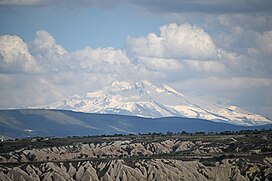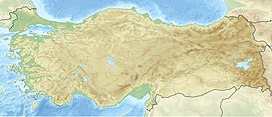| Mount Erciyes | |
|---|---|
 View of Mount Erciyes from Cappadocia | |
| Highest point | |
| Elevation | 3,917 m (12,851 ft) |
| Prominence | 2,419 m (7,936 ft)[1] |
| Listing | Ultra |
| Coordinates | 38°31′52″N 35°26′49″E / 38.531°N 35.447°E[2] |
| Geography | |
| Location | Kayseri Province, Turkey |
| Geology | |
| Mountain type | Stratovolcano |
| Last eruption | 6880 BCE ± 40 years[2] |
Mount Erciyes (Turkish: Erciyes Dağı) is an inactive volcano in Kayseri Province, Turkey. It is a large stratovolcano surrounded by many monogenetic vents and lava domes, and one maar. The bulk of the volcano is formed by lava flows of andesitic and dacitic composition. At some time in the past, part of the summit collapsed towards the east.
The volcano began to form in the Miocene. At first, a volcano farther east named Koç Dağ formed from lava flows. Then, again to the east, large explosive eruptions formed a caldera. During the Pleistocene, Mount Erciyes proper grew inside the caldera together with a group of lava domes. Lateral eruptions of Erciyes may have generated ash layers in the Black Sea and the Mediterranean during the early Holocene.
The last eruptions occurred during the early Holocene and may have deposited ash as far away as Palestine; the occurrence of historical volcanism is uncertain. Future eruptions of Erciyes may endanger the nearby cities to the north. The volcano was glaciated during the Pleistocene. One regular glacier still exists, but is receding.
